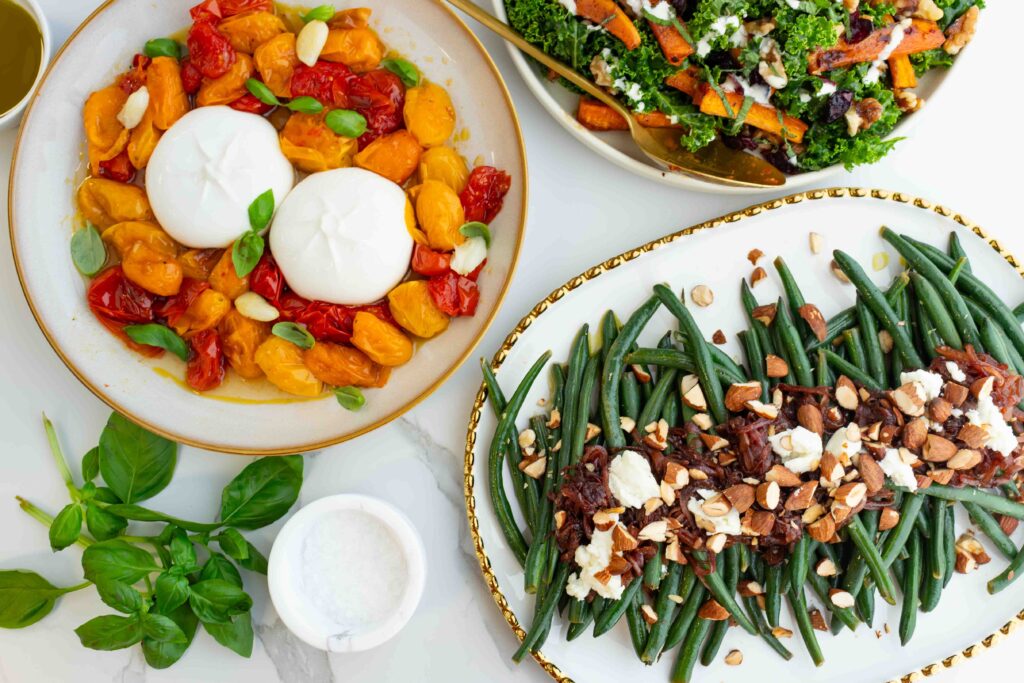Coming up to the end of year, with all the busyness and socialising, I like to check in that I’m getting lots of greens into my meals. There are plenty of reasons why I love greens! From how delicious and nutritious they are in everything from nourish bowls to smoothies, to the way they support your liver, leafy greens really are superfoods. When it comes to supporting healthy skin from the inside-out, greens are at the top of my list of beauty-boosting ingredients. Let’s take a look at why:
The importance of fruit and vegetables
In general, fruits and vegetables have a very important role in health as they contain essential nutrients and phytochemicals that support the body in multiple ways. Specifically when it comes to skin health, these may support or prevent the risk of skin conditions. The connection between diet and skin redness may also reflect the influence of fruit and vegetable intake on the skin’s blood flow. Polyphenols (antioxidants contained in green leafy vegetables) may be beneficial to skin elasticity which may positively influence blood perfusion in the skin.
Green vegetables
Due to their plant pigments, green vegetables contain the highest level of antioxidants, compared to other vegetables and berries contain the highest amount of antioxidants of any fruit. The darker the colour of the plant food – the more antioxidants. Which is why we love our spinach, rocket, broccoli, silverbeet and kale as these are some of the darker of the green vegetables!
Protection from free radicals
A key function of antioxidants is protection from free radical damage. So what exactly are free radicals? The cells in the skin constantly create highly reactive molecules, which are what we know as free radicals. Free radicals can build up in cells and cause damage to other molecules. These free radicals are neutralised by different systems to create a balance. However, when this balance is broken, various structures may suffer, leading to a trigger or worsening of a skin condition. When you understand this, you can see how helpful the abundance of antioxidants provided by leafy green vegetables is for preventing everything from premature ageing to dull skin.
Chlorophyll
Chlorophyll is the most abundant plant pigment and responsible for giving plant foods their green colour. They are specifically high in kale and spinach. This pigment has been found to support and block damage to DNA. Green vegetables like parsley, spinach, watercress, rocket and mint have an extremely high antioxidant activity and are rich in phenols and chlorophyll.
Other nutrients required for skin vitality
Along with antioxidants such as carotenoids, tocopherols and flavonoids, other nutrients abundant in leafy greens, such as vitamins A, C, D E, omega-3, protein and the lactobacilli strain of bacteria, have also been shown to promote healthy skin and support beauty from within.
Tip: Increase your intake of these foods with a greens supplement
A quality green superfood supplement is a great way to pack an extra dose of skin-loving nourishment into your day. I am loving our JSHealth Vitamins Greens + Collagen formula at the moment. This blend includes the benefits of organic Wheatgrass and Barley Grass, along with organic Broccoli, Kale and Spinach. These nutrient-rich greens are bursting with vitamins C, E, K and folate, phytonutrients and antioxidants to support vibrant wellness as part of a varied and balanced diet. We’ve then added our hydrolysed Marine Collagen to replenish collagen levels to help the skin appear plump and hydrated, reduce the appearance of visible signs of ageing, enhancing skin vitality, and supporting healthy hair and nails.
References:
Solway J, McBride M, Haq F, Abdul W, Miller R. Diet and Dermatology: The Role of a Whole-food, Plant-based Diet in Preventing and Reversing Skin Aging-A Review. J Clin Aesthet Dermatol. 2020;13(5):38-43.
Ezgi Doğan Cömert, Burçe Ataç Mogol, Vural Gökmen, Relationship between color and antioxidant capacity of fruits and vegetables, Current Research in Food Science, Volume 2, 2020, Pages 1-10,
Addor FAS. Antioxidants in dermatology. An Bras Dermatol. 2017;92(3):356-362.
Ghosh D, Scheepens A. Vascular action of polyphenols. Mol Nutr Food Res. 2009 Mar;53(3):322-31.



